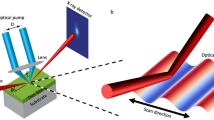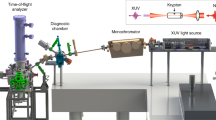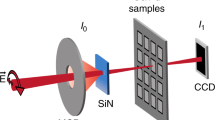Abstract
Optical-domain transient grating (TG) spectroscopy is a versatile background-free four-wave-mixing technique that is used to probe vibrational, magnetic and electronic degrees of freedom in the time domain1. The newly developed coherent X-ray free-electron laser sources allow its extension to the X-ray regime. X-rays offer multiple advantages for TG: their large penetration depth allows probing the bulk properties of materials, their element specificity can address core excited states, and their short wavelengths create excitation gratings with unprecedented momentum transfer and spatial resolution. Here, we demonstrate TG excitation in the hard X-ray range at 7.1 keV. In bismuth germanate (BGO), the non-resonant TG excitation generates coherent optical phonons detected as a function of time by diffraction of an optical probe pulse. This experiment demonstrates the ability to probe bulk properties of materials and paves the way for ultrafast coherent four-wave-mixing techniques using X-ray probes and involving nanoscale TG spatial periods.
This is a preview of subscription content, access via your institution
Access options
Access Nature and 54 other Nature Portfolio journals
Get Nature+, our best-value online-access subscription
$29.99 / 30 days
cancel any time
Subscribe to this journal
Receive 12 print issues and online access
$209.00 per year
only $17.42 per issue
Buy this article
- Purchase on Springer Link
- Instant access to full article PDF
Prices may be subject to local taxes which are calculated during checkout




Similar content being viewed by others
Data availability
The raw data used in this study are available from the corresponding authors upon request.
Change history
11 May 2021
A Correction to this paper has been published: https://doi.org/10.1038/s41566-021-00826-7
References
Goodno, G. D., Dadusc, G. & Miller, R. D. Ultrafast heterodyne-detected transient-grating spectroscopy using diffractive optics. J. Opt. Soc. Am. B 15, 1791–1794 (1998).
Thomson, R., Leburn, C. & Reid, D. (eds) Ultrafast Nonlinear Optics (Springer, 2013).
Mukamel, S. Principles of Nonlinear Optical Spectroscopy 6 (Oxford Univ. Press, 1995).
Hamm, P. & Zanni, M. Concepts and Methods of 2D Infrared Spectroscopy (Cambridge Univ. Press, 2011).
Rogers, J. A., Maznev, A. A., Banet, M. J. & Nelson, K. A. Optical generation and characterization of acoustic waves in thin films: fundamentals and applications. Annu. Rev. Mater. Sci. 30, 117–157 (2000).
Crimmins, T. F., Stoyanov, N. S. & Nelson, K. A. Heterodyned impulsive stimulated Raman scattering of phonon–polaritons in LiTaO3 and LiNbO3. J. Chem. Phys. 117, 2882–2896 (2002).
Redman, D. A. et al. Spin dynamics and electronic states of N–V centers in diamond by EPR and four-wave-mixing spectroscopy. Phys. Rev. Lett. 67, 3420–3423 (1991).
West, B. A., Womick, J. M. & Moran, A. M. Probing ultrafast dynamics in adenine with mid-UV four-wave mixing spectroscopies. J. Phys. Chem. A 115, 8630–8637 (2011).
Dhar, L., Rogers, J. A. & Nelson, K. A. Time-resolved vibrational spectroscopy in the impulsive limit. Chem. Rev. 94, 157–193 (1994).
Janušonis, J. et al. Transient grating spectroscopy in magnetic thin films: simultaneous detection of elastic and magnetic dynamics. Sci. Rep. 6, 29143 (2016).
Tobey, R. I. et al. Transient grating measurement of surface acoustic waves in thin metal films with extreme ultraviolet radiation. Appl. Phys. Lett. 89, 091108 (2006).
Johnson, J. A. et al. Direct measurement of room-temperature nondiffusive thermal transport over micron distances in a silicon membrane. Phys. Rev. Lett. 110, 025901 (2013).
Hua, C. & Minnich, AustinJ. Transport regimes in quasiballistic heat conduction. Phys. Rev. B 89, 094302 (2014).
Behrens, C. et al. Few-femtosecond time-resolved measurements of X-ray free-electron lasers. Nat. Commun. 5, 3762 (2014).
Bencivenga, F. et al. Four-wave mixing experiments with extreme ultraviolet transient gratings. Nature 520, 205–208 (2015).
Bencivenga, F. et al. Nanoscale transient gratings excited and probed by extreme ultraviolet femtosecond pulses. Sci. Adv. 5, eaaw5805 (2019).
Schweigert, I. V. & Mukamel, S. Coherent ultrafast core-hole correlation spectroscopy: X-ray analogues of multidimensional NMR. Phys. Rev. Lett. 99, 163001 (2007).
Svetina, C. et al. Towards X-ray transient grating spectroscopy. Opt. Lett. 44, 574–577 (2019).
Milne, C. J. et al. SwissFEL: the Swiss X-ray free electron laser. Appl. Sci. 7, 720 (2017).
Ingold, G. et al. Experimental station Bernina at SwissFEL: condensed matter physics on femtosecond time scales investigated by X-ray diffraction and spectroscopic methods. J. Synchrotron Radiat. 26, 874–886 (2019).
Raymond, S. G. & Townsend, P. D. The influence of rare-earth ions on the low-temperature thermoluminescence of Bi4Ge3O12. J. Phys. Condens. Matter 12, 2103–122 (2000).
Williams, P. A. et al. Optical, thermo-optic, electro-optic and photoelastic properties of bismuth germanate (Bi4Ge3O12). Appl. Opt. 35, 3562–3569 (1996).
Kaminskii, A. A. et al. Growth, spectral and luminescence study of cubic Bi4Ge3O12:Pr3+ crystals. Phys. Status Solidi A 85, 553–567 (1984).
Brunner, S. E. & Schaart, D. R. BGO as a hybrid scintillator/Cherenkov radiator for cost-effective time-of-flight PET. Phys. Med. Biol. 62, 4421–4439 (2017).
Tao, L., Coffee, R. N., Jeong, D. & Levin, C. S. Ionizing photon interactions modulate the optical properties of crystals with femtosecond scale temporal resolution. Phys. Med. Biol. 66, 045032 (2021).
Kamada, O. & Kakishita, K. Electro-optical effect of Bi4Ge3O12 crystals for optical voltage sensors. Jpn J. Appl. Phys. 32, 4288–4291 (1993).
Kaminskii, A. A. et al. Growth, spectroscopy and stimulated emission of cubic Bi4Ge3O12 crystals doped with Dy3+, Ho3+, Er3+, Tm3+ or Yb3+ ions. Phys. Status Solidi A 56, 725–736 (1979).
Li, C. & Yoshino, T. Simultaneous measurement of current and voltage by use of one bismuth germanate crystal. Appl. Opt. 41, 5391–5397 (2002).
Chen, Z., Gao, Y., Minch, B. C. & DeCamp, M. F. Coherent optical phonon generation in Bi3Ge4O12. J. Phys. Condens. Matter 23, 385402 (2011).
Couzi, M., Vignalou, J. R. & Boulon, G. Infrared and Raman study of the optical phonons in Bi4Ge3O12 single crystal. Solid State Commun. 20, 461–465 (1976).
Maznev, A. A. et al. Generation of coherent phonons by coherent extreme ultraviolet radiation in a transient grating experiment. Appl. Phys. Lett. 113, 221905 (2018).
Norman, P. & Dreuw, A. Simulating X-ray spectroscopies and calculating core-excited states of molecules. Chem. Rev. 118, 7208–7248 (2018).
Miao, H., Gomella, A. A., Chedid, N., Chen, L. & Wen, H. Fabrication of 200-nm period hard X-ray phase gratings. Nano Lett. 14, 3453–3458 (2014).
Vila-Comamala, J. et al. Ultra-high resolution zone-doubled diffractive X-ray optics for the multi-keV regime. Opt. Express 19, 175–184 (2011).
Lynch, S. K. et al. Fabrication of 200-nm period centimeter area hard X-ray absorption gratings by multilayer deposition. J. Micromech. Microeng. 22, 105007 (2012).
Cho, J., Hwang, T. Y. & Zewail, A. H. Visualization of carrier dynamics in p(n)-type GaAs by scanning ultrafast electron microscopy. Proc. Natl Acad. Sci. USA 111, 2094–2099 (2014).
Gorfien, M. et al. Nanoscale thermal transport across an GaAs/AlGaAs heterostructure interface. Struct. Dyn. 7, 025101 (2020).
Grilj, J. et al. Self-referencing heterodyne transient grating spectroscopy with short wavelength. Photonics 2, 392–401 (2015).
Katayama, K., Yamaguchi, M. & Sawada, T. Lens-free heterodyne detection for transient grating experiments. Appl. Phys. Lett. 82, 2775–2777 (2003).
Tanaka, S. & Mukamel, S. Coherent X-ray Raman spectroscopy: a nonlinear local probe for electronic excitations. Phys. Rev. Lett. 89, 043001 (2002).
Makita, M. et al. Fabrication of diamond diffraction gratings for experiments with intense hard X-rays. Microelectron. Eng. 176, 75–78 (2017).
Acknowledgements
This study was supported by the Swiss National Science Foundation (SNSF, grant no. 200021_165550/1), the SNSF research instrument NCCR Molecular Ultrafast Science and Technology (NCCR MUST, grants 51NF40-183615 and 200021_169017), the ERC Grant ‘DYNAMOX’ (ERC-2015-AdG-694097) and the EU-H2020 Research and Innovation Programme under the Marie Skłodowska-Curie grant agreements (701647, 654360 NFFA-Europe, 801459-FP-RESOMUS and 871124 Laserlab-Europe). The contribution of the MIT participants A.A.M. and K.A.N. was supported by the US Department of Energy award DE-SC0019126. We thank M. Dzambegovic for the graphical rendering of Fig. 1a.
Author information
Authors and Affiliations
Contributions
C.S. conceptualized the framework of the experiment. J.R.R. and C.S. designed the experiment. G.S. and C.D. fabricated the diamond gratings. B.R. carried out the optical microscopy of the static printed gratings. All members of the team participated in the experiment and were involved in the discussions. J.R.R., D.F. and E.F. carried out the data reduction. J.R.R., D.F. and C.S. performed the data analysis. C.S., J.R.R. and D.F. wrote the manuscript.
Corresponding authors
Ethics declarations
Competing interests
The authors declare no competing interests.
Additional information
Peer review information Nature Photonics thanks Ryan Coffee and the other, anonymous, reviewer(s) for their contribution to the peer review of this work.
Publisher’s note Springer Nature remains neutral with regard to jurisdictional claims in published maps and institutional affiliations.
Supplementary information
Supplementary Information
Supplementary Figs. 1–11, Discussion and Tables 1–3.
Rights and permissions
About this article
Cite this article
Rouxel, J.R., Fainozzi, D., Mankowsky, R. et al. Hard X-ray transient grating spectroscopy on bismuth germanate. Nat. Photon. 15, 499–503 (2021). https://doi.org/10.1038/s41566-021-00797-9
Received:
Accepted:
Published:
Issue Date:
DOI: https://doi.org/10.1038/s41566-021-00797-9
This article is cited by
-
Transient responses of double core-holes generation in all-attosecond pump-probe spectroscopy
Scientific Reports (2024)
-
Progress and prospects in nonlinear extreme-ultraviolet and X-ray optics and spectroscopy
Nature Reviews Physics (2023)
-
Transient gratings with X-rays
Nature Photonics (2021)
-
Optical transient grating pumped X-ray diffraction microscopy for studying mesoscale structural dynamics
Scientific Reports (2021)



